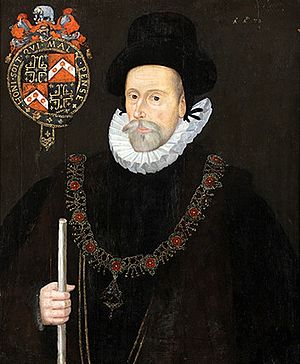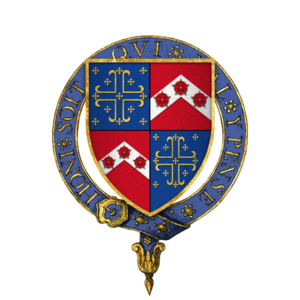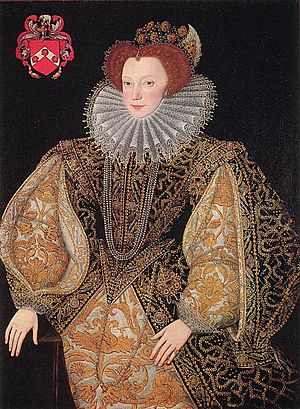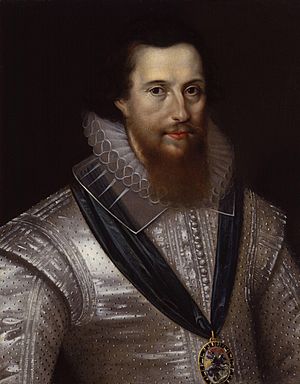Francis Knollys (the elder) facts for kids
Quick facts for kids
Sir Francis Knollys
|
|
|---|---|

Sir Francis Knollys
|
|
| Born | c.1511 or c.1514 |
| Died | 15 July 1596 (aged 84 or 85; 81 or 82) |
| Buried | Rotherfield Greys, Oxfordshire |
| Spouse(s) | Catherine Carey |
| Issue |
|
| Father | Robert Knollys |
| Mother | Lettice Peniston |
Sir Francis Knollys (born around 1511 or 1514 – died 19 July 1596) was an important English nobleman and politician. He served three different English monarchs: King Henry VIII, King Edward VI, and Queen Elizabeth I. He was also a Member of Parliament, which means he helped make laws for the country.
Contents
Early Life and Royal Service
Francis Knollys was born around 1511. His father was Sir Robert Knollys. Francis likely received a good education, possibly at Oxford.
He married Catherine Carey, who was the first cousin of Queen Elizabeth I. King Henry VIII liked Francis and gave him the estate of Rotherfield Greys in 1538. Francis also became one of the gentlemen-pensioners at court. This meant he was a personal guard and attendant to the King.
In 1542, he became a Member of Parliament for the first time, representing Horsham.
Serving King Edward VI
When King Edward VI came to the throne, Francis Knollys continued to serve the royal family. He was a strong Protestant, which meant he supported the new Church of England. This pleased the young King Edward and his sister, Princess Elizabeth.
In 1547, Francis was made a knight after a battle in Scotland. He spent a lot of time at court, even taking part in religious discussions. He was given more land, including the manors of Caversham and Cholsey.
A Time of Change: Exile and Return
When Queen Mary I became queen in 1553, things changed for Francis Knollys. Queen Mary was a Catholic, and she wanted to bring the Catholic faith back to England. Because Francis was a strong Protestant, he decided it was safer to leave England.
He went to Germany, living first in Frankfurt and then in Strasbourg. He helped other English Protestants who were also living in exile.
Return to England and New Roles
Before Queen Mary died, Francis returned to England. When Queen Elizabeth I became queen in 1558, she welcomed him back. She knew he was a trustworthy person who supported the Protestant religion.
Francis was made a member of the Privy Council, which was a group of close advisors to the Queen. He also became the Vice-Chamberlain of the Household. His wife, Catherine, became a lady of the Queen's privy chamber.
In 1559, he became a Member of Parliament for Arundel. Later, he represented Oxfordshire until his death.
Working for Queen Elizabeth
Francis Knollys was a very busy man, holding many important jobs for Queen Elizabeth.
In 1563, he was the governor of Portsmouth, an important port city. He also traveled to Ireland in 1566 to help manage the army's spending during a rebellion. He realized that fighting rebels was expensive and couldn't be done cheaply.
He was also the treasurer of the Queen's chamber and later the Treasurer of the Household. This meant he managed the Queen's money and household expenses.
Looking After Mary, Queen of Scots
One of Francis Knollys's most important and difficult jobs was looking after Mary, Queen of Scots. In 1568, Mary fled to England and asked Queen Elizabeth for help. Elizabeth decided to keep Mary under guard.
Francis Knollys was put in charge of Mary at Carlisle Castle. He found Mary very charming, but he had to tell her that Queen Elizabeth would not help her regain her throne. He also had to mention the suspicions surrounding the death of Mary's husband, Lord Darnley.
Later, Mary was moved to Bolton Castle. Francis tried to make her stay more pleasant by teaching her to write and speak English. He also tried to convince her to become a Protestant. He even wrote to Queen Elizabeth, asking to be relieved of this duty, but he stayed with Mary until she was moved to another location in 1569.
His Strong Beliefs
Francis Knollys was a very strong Puritan. Puritans were Protestants who wanted to make the Church of England even simpler and more "pure," removing anything they felt was too similar to Catholicism.
He often spoke out in Parliament and to the Queen about his beliefs. He believed that bishops had too much power and that the Church should be run differently. He was not afraid to tell Queen Elizabeth when he disagreed with her policies, especially if he thought they were not good for the Protestant faith. He warned her about the dangers of Catholicism and asked her to support Protestants more strongly.
He also helped try people accused of plotting against the Queen, including Anthony Babington and even Mary, Queen of Scots. He strongly believed Mary should be executed for her role in plots against Elizabeth.
Family Life
Francis Knollys married Catherine Carey in 1540. They had a large family with 15 children.
- Mary Knollys (born around 1541)
- Sir Henry Knollys (born around 1542), who was also a Member of Parliament.
- Lettice Knollys (born 1543), who became the Countess of Essex and later the Countess of Leicester.
- Sir William Knollys (born around 1544), who became the 1st Earl of Banbury.
- Edward Knollys (born 1546), a Member of Parliament.
- Sir Robert Knollys (born 1547), also a Member of Parliament.
- Richard Knollys (born 1548), a Member of Parliament.
- Elizabeth Knollys (born 1549), who married Sir Thomas Leighton.
- Maud Knollys (born around 1550), who died young.
- Sir Francis Knollys "the Younger" (born around 1552), a privateer and admiral.
- Anne Knollys (born 1555), who married Thomas West, 2nd Baron De La Warr. The state of Delaware is named after her husband's family.
- Sir Thomas Knollys (born 1558), a soldier.
- Catherine Knollys (born 1559).
- Cecily Knollys (born around 1560).
- Dudley Knollys (born 1562), who died young.
Francis Knollys was given the high honor of being a Knight of the Garter in 1593. He died on 19 July 1596 and was buried at Rotherfield Greys. His monument in the church there shows statues of his many children.
See also
- Knollys (family)




